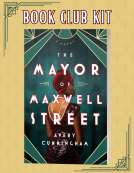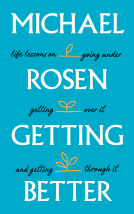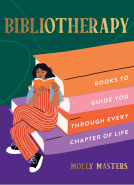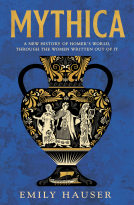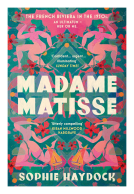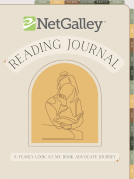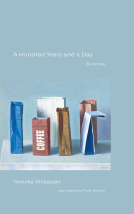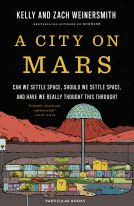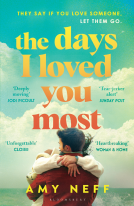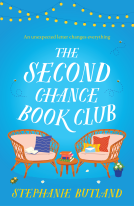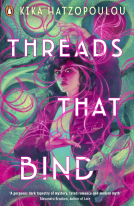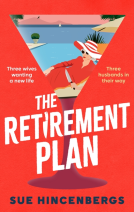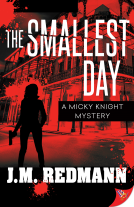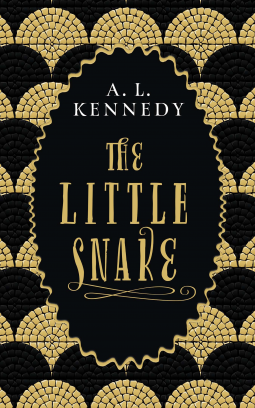
The Little Snake
by A.L. Kennedy
This title was previously available on NetGalley and is now archived.
Send NetGalley books directly to your Kindle or Kindle app
1
To read on a Kindle or Kindle app, please add kindle@netgalley.com as an approved email address to receive files in your Amazon account. Click here for step-by-step instructions.
2
Also find your Kindle email address within your Amazon account, and enter it here.
Pub Date 8 Nov 2018 | Archive Date 8 Nov 2018
Talking about this book? Use #TheLittleSnake #NetGalley. More hashtag tips!
Description
“Some time ago, perhaps before you were even born, a young girl was walking in her garden. She may have been called Mary - that's what most of the stories say. Mary was a little bit taller than the other girls her age and had brownish crinkly hair. She was quite thin, because she didn't always have exactly enough to eat. She liked honey and whistling and the colour blue and finding out."
This is the story of Mary, a young girl born in a beautiful city full of rose gardens and fluttering kites. When she is still very small, Mary meets Lanmo, a shining golden snake, who becomes her very best friend. The snake visits Mary many times, he sees her city change, become sadder as bombs drop and war creeps in. He sees Mary and her family leave their home, he sees her grow up and he sees her fall in love. But Lanmo knows that the day will come when he can no longer visit Mary, when his destiny will break them apart, and he wonders whether having a friend can possibly be worth the pain of knowing you will lose them.
Available Editions
| EDITION | Hardcover |
| ISBN | 9781786893864 |
| PRICE | £9.99 (GBP) |
| PAGES | 144 |
Featured Reviews
 Antonomasia T, Reviewer
Antonomasia T, Reviewer
This tiny novella lives somewhere in that realm of books which are between/both, neither/nor, children's/adults' stories, also inhabited by certain works of Neil Gaiman, Catherynne M. Valente, and other authors I could think of if I read more of this sort of thing.
It begins like a children's book, or maybe the sort of modern fairytale or fable that is very definitely meant to sound like one. I was wrongfooted. I didn't know what to say about a children's book qua children's book. I'd requested this ARC as a fan of A.L. Kennedy, not as someone who enjoys children's books, or works with or has children. (So should my verdict be whether I would, in theory, consider buying it as a present?) I'm still on some level the same person who unilaterally decided to stop watching Children's BBC before starting secondary school, and who found the introduction to a Penguin Classic more interesting than a Point Horror. I couldn't remember enjoying this sort of thing as a child or teenager, or if much was even written in this elaborately storytellerish manner in the 1980s and earlier.
In the acknowledgements, Kennedy thanks Saint-Exupéry, and the German blurb references his 'kleiner Prinz'. I didn't read <i>The Little Prince</i> until my twenties, and then only because of the <a href="https://en.wikipedia.org/wiki/The_Big_Read">BBC Big Read</a>; it didn't make much of an impression, and it wasn't a book I heard others talk about (other than, more recently, a few GR friends). Read outside the context of <i>The Little Prince</i>, the emphases in <i>The Little Snake</i> may seem somewhat different from what they would if the book is taken as a companion piece. Some readers will pick up <i>The Little Snake</i> without having read Exupéry, or having entirely forgotten his book, so I've intentionally left my reactions as they were before I read a plot summary as a refresher.
<i>The following contains potential spoilers about themes - which I started the book without knowing - but specific plot-points are in spoiler tags.</i>
But today the tale of <i>The Little Snake</i> - and its heroine, Mary, the sort of very clever girl who might not have been able to be both such a swot and a heroine before Hermione - became quite engrossing, and there was also plenty to analyse without fretting that I'd forgotten how to think about fiction like an eight-year-old.
There are one-off references to amuse older readers, such as the comical name given to a bloodthirsty dictator, which made me long to know exactly when in 2016 this story was written, and fourth-richest man in the world Lembit Quartak, whose name brings to mind weirder-than-Alan-Partridge UK media personality and former MP <a href="https://en.wikipedia.org/wiki/Lembit_%C3%96pik">Lembit Öpik</a>. Mary's school's preoccupation with National Assessment Tests will ring true with anyone, child or adult, aware of present conditions in English schools. On the other hand, I wasn't sure about the phrase initially used to describe the very richest, 'the people who run the city', which could imply that people who work for local councils are the wealthiest, rather than corporate fat cats - although it didn't continue in that vein.
<i>The Little Snake</i> seems somehow more profoundly, subtly dark than a lot of Neil Gaiman stories: there is definitely humour here (with lines that remind one that Kennedy is also a comedian), but the fable is partly about comfort and magic in a bleak world. Most Earth-bound protagonists of Gaiman short stories or children's books are materially quite comfortable, or you don't feel it this acutely, somehow, that they aren't. But <i>The Little Snake</i> is still 'suitable for children' in the same way as many children's novels set during wars and other tough historical times are.
There were points when I thought this was going to be an exploration of the interesting question of what if a magical creature that befriends a child in a story turned out not to be perfectly good. Not all bad in a rigid black-and-white sense, but complicated in the way that real people often are - and of how one might deal with that as part of learning about boundaries in friendship. It's also perhaps about how those who've had very different lives might sometimes make mistakes socially. (These are both part of a conversation it might make sense to have if reading this aloud with a child.) <spoiler>It also made me think about the portrayals of Death in Discworld and <i>Sandman</i>: suddenly I felt that they could have done with a little more ... edge, feel a touch more threatening and sinister as the Snake here sometimes does. He feels more... Deathy. It makes sense that Death wanting to be friends with a live human would make mistakes and sometimes sound a bit off.</spoiler>
I increasingly found myself wondering about that 'when in 2016'... or earlier?
Reading now, in late summer 2018, about the gradually worsening living conditions in Mary's home town, felt like the first artistic response I'd read to recent concerns about no-deal Brexit, and I was so caught up in the cathartic relief of actually seeing it that I would sometimes forget for a while that the story isn't brand new. (A.L. Kennedy is popular in Germany, and in recent years has won more awards there than in the UK. <i>The Little Snake</i> was published first in German, in 2016. Some minor characters have German names.) Maybe it was written just after the referendum - though a bit of a rush to get it translated and published in Germany for October. Later, though, I felt it may be part of the literary response to the refugee crisis, along with novels like Mohsin Hamid's [book:Exit West|30688435]. Whether it's kind-of-about Brexit anxieties, or refugees, or both, it also echoes the economic privations of Weimar, and the destruction of cities during the Second World War.
Regardless of potential subtext, it is an absorbing, sometimes wry and moving modern fairy tale following the main character through her life, and it appears to be printed in a very nice gift edition.
<i>I received a free advance review copy from Netgalley and the publisher, Canongate Books.</i>
 Sue B, Reviewer
Sue B, Reviewer
Thankyou to NetGalley, Canongate Books and A.L Kennedy for the opportunity to read an advanced readers copy of The Little Snake.
This book is an exceptional read. I thought it was beautifully written and an engrossing tale. The book seemed to come alive. I really enjoyed reading this book and appreciate being given the opportunity to read it before it's official release date.
Would highly recommend this book.
 Nick B, Reviewer
Nick B, Reviewer
The Little Snake is a children’s story about a young girl, Mary, who befriends a beautiful golden snake called Lanmo. Mary lives in a fantasy land where people fly kites from their rooftops. Mary’s heart is pure and her willingness to converse with objects and animals opens up a charming world where she can bridge the gap between the real and the magical. The language is playful with the narrator making lots of asides and quips to the reader. There are lots of cutesy snakey words and cuddly imagery.
But all is not as it seems.
Mary’s city is deeply divided between rich and poor. Racism is rampant and diversity is a dirty word. The residents want to pull up the drawbridge, not seeing the wonderful cultural and social advantages that could be brought with more imagination. Mary’s parents are struggling to make ends meet as the city plunges into economic stagnation. War is a constant threat. Lanmo is actually a supernatural manifestation of death.
So, these two angles inhabit the same short novella. Lanmo invites Mary to teach him about the ways of humans, about the ways of friendship and love. Lanmo learns to taste emotions; with a quick flick of his tongue, he can read a person and determine a fate. Lanmo and Mary share their bewilderment at the paradoxical life-choices of humans. And time passes.
Meanwhile at night – and later for extended periods – Lanmo goes about his work, travelling across vast distances to seek out those whose time has come to an end. This offers an opportunity for vignettes – the warrior king, the dancing lovers, the third (or fourth) richest man in the world – and derive a wry look at human nature from their reaction to Lanmo.
This ability to see ourselves from an outsider, alien perspective is very well done. Particularly as it moves from the bleeding obvious to more subtle and nuanced behaviours. But most of all, the joy is from the comic narration. Scenes like Lanmo trying to eat Mary’s pet kitten, for example, or the deadpan assertion of the importance of testing in schools.
The Little Snake is an absolute treasure trove of wit, perceptiveness, prose-poetry and charm. The amount that AL Kennedy has packed into so few pages is breathtaking. There is no flab, no redundancy anywhere in this perfect little book. I loved every minute and have to resist the temptation to start all over again.
 c c, Reviewer
c c, Reviewer
I was so moved by this short story about Mary and the snake. It is written like a fable, appropriate for both children and adults. I find it fascinating that the author has managed to touch on themes like war, love, friendship and death in such a seemingly simple way. While Mary's journey was touching I found most affecting the descriptions of Lanmo the snake as he also grew and changed. Even nonsensical words made complete sense in the world of the story, as Lanmo sleeked about the world and tasted the human existence. Beautiful.
NO SPOILERS
Having not read anything by A L Kennedy before, I was not sure if this was going to be a book for children or adults but I know now that it is wonderful for all.
Mary (I like that the name is simple and classic) is befriended by a beautiful, mysterious, golden snake whom she chooses to call Lenmo…she has a choice from several names. It is a friendship which lasts a lifetime in spite of the snake’s purpose.
The writing is simple yet detailed, rhythmic, beautiful, magical and charming…not unlike the snake. The allusions are strong, giving this delightful story the air of a fable.
But, and for me there is a but, this book deserves a better written final chapter as it feels rushed and careless. The magic is missing and compared to the rest it reads like a quick draft. Don’t let this put you off though…the rest more than makes up for it.
But, (here’s another but) I read this in one afternoon and was totally absorbed. This book would be ideal for a reading group; it is short but exceptionally sweet and Lenmo asks many questions we should perhaps all ask ourselves. There is much here to inspire discussion, of both the style and the comment. (It also has a gorgeous cover, which is somewhat rare these days!)
So, do take an afternoon to put the kettle on or open a bottle and sit undisturbed with The Little Snake. It will leave a smile on your lips and questions on your mind. (Snakes have no lips…)
Thank you to NetGalley and Canongate for the Advanced Reader Copy of the book, which I have voluntarily reviewed.
 Reviewer 451445
Reviewer 451445
While I like A L Kennedy as a writer I had no idea what to expect from this latest offering.
I'm not entirely sure how to categorise it other than to say it's like a fable. It could actually be said to centre around death and the life we live in the situations we're in in the face of inevitable death. There is love and sadness and joy and sorrow. It is charming and magical and thought provoking and written in very simple and uncomplicated language. We see the world from a child's point of view mostly through the eyes of the young girl called Mary and I confess I loved at the beginning when we meet her and are given insight into how her mind creates vast spaces from a tiny garden. One of the big plot lines, if I can call it that, is how death copes (changes) when experiencing love. The snake disappears at regular intervals to go about its business with other people (trying not to enter spoiler territory here!) and we meet some curious characters and it feels like we're being given special and privileged insight into one of the most emotive periods of life, death. I confess I particularly loved the scenes with the dancing couple later in the book. Kennedy provides a real emotional 'hit' within the confines of effectively very little prose and that is surely a skill in itself. At times I thought I knew what period the book is set in but then I settled on the thought that it's probably written so that it could be set in any time or place and thus is timeless. It is fairly short at 144 pages and I wasn't sure whether this was about enough or if I wanted it to continue and hopefully explain a bit more, especially about the nature of the little snake. I think that's the one thing that I was slightly dissatisfied with, that the ending left me feeling like I wanted to know a bit more than the story allowed me. But then maybe that's partly the point of the fable, if that's what it is, to leave you to take the story where it goes in your own mind. I'd definitely recommend it and can see book groups having great fun interpreting it.
Thanks to NetGalley and Canongate Books for an advance copy for review purposes.
 Ruth M, Reviewer
Ruth M, Reviewer
When the latest AL Kennedy publication came up for grabs on NetGalley, I didn’t hesitate. The other books of hers that I’ve read have been dark, thought-provoking, not always the easiest of reads. So the last thing I was expecting was this utterly charming, heartbreaking little fable in the vein of The Little Prince.
The snake in question is “the kind of snake that is never in books”. It has many names, can take on many shapes, seems to be immortal, and has a job to do which humans are increasingly doing for it. At the start we are told that “this is almost, but not quite, the whole of the story about a remarkable, wise little girl” called Mary. By the end, it is almost, but not quite, the story of Mary “and the friend that she called Lanmo... and... almost, but not quite, the whole of the story of how a snake’s heart learned to beat”.
The snake is generally not seen by humans until it is their time to see it. Mary, however, is different. She is a bit taller than other girls her age, has brown, crinkly hair, and likes honey and whistling and the colour blue and finding out. She lives in an apartment building that is only a little bit squashed, with a rooftop garden a bit bigger than a big tablecloth, in an expensive city of two halves where the rich live in unimaginable luxury and there aren’t many parks. She is very sensible and therefore knows better than to only talk to people. So when she notices a beautiful golden shimmering bangle around her ankle, with two glimmering jewels, she immediately strikes up a conversation. The bangle turns out to be an immensely fast and handsome little snake with a beautiful speaking voice. Of the many names it volunteers, Mary chooses Lanmo. And thus starts a friendship that will protect Mary throughout her journey through life, and teach Lanmo the meaning of love.
Lanmo goes to school with Mary, where, buoyed up by having a new friend, she asks the Very Attractive Girls if she can join in their play during lunch break. When they humiliate her, Lanmo experiences such fury that he loses control to such a degree that he accidentally brushes Mary with one of his lethal killing fangs. She faints but awakens unscathed apart from acquiring a streak of twenty-one white hairs, but he is guilt-ridden for the first time ever and tells Mary he needs to go away for a while until he understands what is happening and learns not to be angry. He promises to send her sweet dreams every night, then disappears. For two years.
As Mary grows, the world becomes a darker place. Lanmo passes, “faster than threats or rumours”, over the world, and is always busy, but knows he would have been much busier had it not been for humans helping him - he can sense “the many, many times the humans of each darkened land... worked hard and saved him the task of visiting this or that other human and showing them his needle teeth as white as bones and making them hear his beautiful voice and look into his honest red eyes”.
When he returns to see Mary, it is apparent that the darkness is spreading to her city too, and war is looming. There is rationing and deprivation, and life is hard. But Mary is in the throes of first love, with a ginger-haired boy called Paul, every bit as sensible and open and good as she is, and she is in any case a mostly happy person. And all the deprivations cannot corrupt the love in her close-knit family. Lanmo asks her to explain love, which he has recently started to taste in many humans since meeting Mary and understanding that this is what he feels for her. And as he continues to travel the world and do his job, he starts to observe more and more love in the humans he visits, and finds himself moved to weep, and does not understand why.
On his next return to Mary’s city, things have deteriorated further, and Mary and her family are gone, but she has left him a note, and sends him all the love she has left after loving her parents and Paul and Shade the cat. And he lies down on her bed, and for the first time ever, his heart begins to beat. And he finds Mary and Paul, and learns to cry for joy. But it always seems strange to him that “so many humans would use so many ingenious machines and so many ingenious methods to rush each other out of this world, when all of them must leave their lives in any case”.
They are many wonderful moments of observation. Lanmo’s first encounter with strawberry ice cream is an absolute joy and gives him a “freezy frozey tongue”. The scene where he mistakes Mary’s kitten for a tasty snack and swallows it whole is very reminiscent of the Little Prince’s drawing of the boa constrictor swallowing an elephant (the kitten is regurgitated unharmed).
Lanmo guides Mary and Paul through a perilous journey to the safe haven of Perditi, sending them dreams to teach them how to survive and ensuring that, unlike most humans, they will never be lost. And many, many years later, when Mary’s twenty-one white hairs have become impossible to see because all her hair is white, Lanmo visits her one more time.
This is a perfectly formed little jewel of a tale, encompassing a world of sadness and hope in its slender form. It is “almost, but not quite, the whole of the story of something wonderful and terrible and strange”. Read it.
 Lisa H, Educator
Lisa H, Educator
I loved this book!
A wonderful fable on so many levels and people of all ages can take something from it. The book is beautifully written and so gentle and delicate. Despite a life-long fear of snakes, I empathised with Lamno and admired Mary for her relationship with Lamno. I feel I need to read the tale again already to take even more from it.
Thank you for the opportunity to 'A Little Snake' - I will be recommending it to everyone!
 Ali T, Reviewer
Ali T, Reviewer
Very different from her usual style of writing, A L Kennedy has written a novella for adults based on St Exupery's well-loved children's picture book, The Little Prince. The Little Snake is a fable that gently reminds us that life is more than building great cities and fighting over resources; life can be lived in a small, simple way accepting loss and embracing love. If you take tiny steps across a small garden it makes it appear so much bigger. This is a beautifully-told story, sometimes tongue-in-cheek, that quickly gets its point across and, if you're familiar with this type of fable it won't really work for you. I would pitch it more for a YA audience, or for very stressed out adults. But it's still a timely nudge to all of us to slow down and to remember that simple activities like flying a kite, being kind to our friends and sharing food is all we need to be happy in life.
For such a short piece of work and something that written in such a simple style, I wasn't expecting to fall so utterly in love with this novella. Like the best fables, The Little Snake encompasses many themes within its text, some more prominent than others, but they all never fail to leave a mark.
Moving and Poignant. Deserves multiple readings.
With thanks to Canongate and Netgalley for the ARC in exchange for an honest review.
 Val K, Reviewer
Val K, Reviewer
Although I knew of A L Kennedy I had never read any of her books. I'm not sure why I decided to try this one, as it's not the kind of thing I would normally read, but I'm glad I did. A charming whimsical tale, in another world (or maybe the future!) of a little girl and a golden snake. I thoroughly enjoyed it.
 Alan M, Bookseller
Alan M, Bookseller
‘This is almost, but not quite, the whole of the story of something wonderful and terrible and strange.’
Since she arrived on the literary scene in the early 1990s A.L. Kennedy has been, I admit it up front, one of my favourite writers, and her books such as ‘So I Am Glad’ and ‘Day’ have shown her to be one of our finest living writers. This short book gets its UK publishing debut (it was originally published in Germany in 2016) and is a moving story for our times. Fable, allegory – call it what you will, it is superficially a simple tale of a young girl Mary who is befriended by a talking snake, whom she calls Lanmo, in her tiny garden in a city riven by social injustice and in a land torn apart by war and devastation. The language is often simple, childlike, as we re-learn to see the world through the innocent and prelapsarian eyes of the young, and as Lanmo, centuries old, starts to appreciate the basic humanity and love in (some) people.
The myth or fable analogies are numerous, from the serpent in the garden of Eden, to fairy tale elements such as kindly grandmothers and siblings banished and exiled. In such a short book Kennedy’s mastery takes swipes at the education system, poverty and social injustice, the futility of war, and the plight of migrants. None of this is done in a preachy way, the structure and style of the fable-like story simply and perfectly illustrates her points. There are moments of love and humanity, of friendship and hope, to offset the bleak vision. Kennedy always has a way of playing with language, to cut through to basic emotions and leave you, once the final word has been read, thoughtful and deeply moved. This is a wonderful parable for our times, and I urge you to read it! A definite five-star recommend!
(With thanks to the publisher and NetGalley for an ARC in return for an honest and unbiased review.)
Actual rating 4.5/5 stars.
What an utterly charming, little read! This held in its pages pure magic, the likes of which I have not had the pleasure of reading since The Little Prince. It managed to perfectly capture the breath-taking beauty of a withheld belief in magic, with a moralistic undertone that gave this a painfully poignant edge. Both colluded to make this a delightful story of wonder, told in a lyrical yet simple writing style that embodied traditional fairy tales, and that holds a dual appeal for adults and children alike.
 John L, Reviewer
John L, Reviewer
Four and a half stars.
A really quite wonderful little book (it takes just a couple of hours at most) of a young girl who befriends a magical snake, who we soon learn is the embodiment of justice and death. That lends it a sense of ''The Book Thief'', and I hope this fable sells as many copies as that did, for it's About Life in a similar way, and is full of clever plotting, heartwarming (and -breaking) events, and with a character all its own. I found it didn't quite provide the 'must-read-another-page-then-another' urge of the best of the best books, but this really was most pleasant on the whole.
My thanks to Canongate Books for an eARC of ‘The Little Snake’ via NetGalley.
Mary is a young girl who befriends a beautiful golden little snake in her family’s garden. He is a magical creature able to talk (among other things). Their friendship over the years transforms both. The true nature of the snake and its task in the world is quite understated though clear.
‘The Little Snake’ is told in the style of a fable. At the beginning it reminded me some of a Neil Gaiman or Roald Dahl story as it initially portrays Mary’s world in terms that are quite comic and slightly surreal. As the story continues it moves into darker territory exploring themes of greed, poverty, violence, and war. Yet there is also love, friendship and loyalty to balance the scales.
A delicate, charming and bittersweet story and hopefully one that will move some readers to a greater sense of compassion.
Rich in symbolism it was a delight to read from start to finish, though it also made me think. I cried a bit at its ending. One that I shall likely reread and given its themes and potential for discussion recommend as a reading group selection.
Readers who liked this book also liked:
Tomoka Shibasaki
General Fiction (Adult), Literary Fiction, Novellas & Short Stories
